You're about to enter the peculiar world of 16th-century Strasbourg, where hundreds of people succumbed to an inexplicable urge to dance uncontrollably. As you explore this bizarre episode, you'll encounter a city plagued by famine and disease, whose authorities initially supported the dancing, even hiring musicians to keep the momentum going. But what triggered this strange phenomenon, and how did it spiral out of control? Theories abound, from mass hysteria to medical disorders, but the root cause remains a mystery, waiting to be unraveled. The question is, what will you discover?
Key Takeaways
- The Strasbourg Dancing Plague began with Frau Troffea's week-long dance in July 1518 and eventually affected approximately 400 individuals.
- The cause of the plague remains unclear, with theories including divine punishment, mass hysteria, and involuntary movement disorders like chorea.
- Initial remedies from city authorities, such as hiring musicians, fueled the frenzy, before shifting to prohibiting public dancing as the crisis worsened.
- The dancing lasted for days, indicating an unlikely single physical cause, with local stressors like famine and disease potentially triggering the phenomenon.
Historical Accounts of the Plague
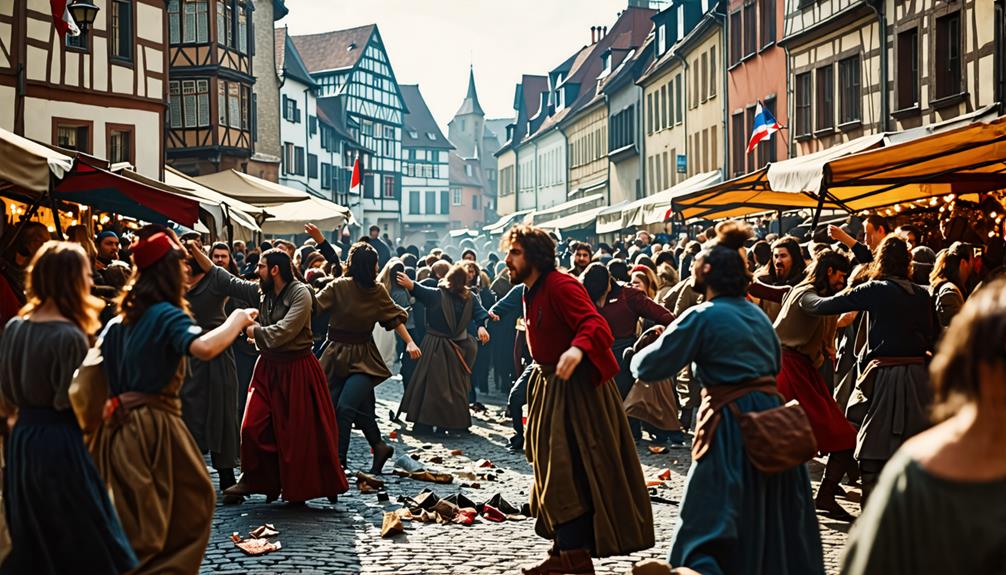
As you explore the historical accounts of the Strasbourg Dancing Plague, you'll find that the first recorded instance of the bizarre phenomenon was Frau Troffea's week-long, uncontrollable dance in July 1518. This event sparked a chain reaction that would eventually engulf hundreds of others.
You'll notice how the dancing quickly became contagious, with approximately 400 individuals succumbing to the compulsion by August. Historical records from the time reflect a range of interpretations regarding the cause, including suggestions of divine punishment and mass hysteria.
Strasbourg's city authorities were baffled, and their initial attempts to remedy the situation only fueled the frenzy. These accounts provide a fascinating glimpse into a moment when the city was gripped by an inexplicable mania for dancing.
Medical Theories and Explanations

Multiple medical theories attempt to explain the bizarre phenomenon of the Strasbourg Dancing Plague, ranging from mass psychogenic illness to involuntary movement disorders.
You might be wondering what could have triggered such a strange and widespread behavior. Historian John Waller suggests that extreme local stressors, such as famine, disease, and societal pressures, may have contributed to the outbreak's psychological triggers. This theory is supported by the fact that the dancing lasted for days, which makes it unlikely that a single physical cause, like ergot poisoning, was responsible.
Another theory links the phenomenon to involuntary movement disorders, such as chorea, which could explain the symptoms exhibited by the dancers.
Some historical interpretations, however, attributed the dancing to divine punishment or demonic possession, reflecting the limited medical understanding and societal beliefs of the time.
Controversy Surrounding the Deaths
Estimates of the death toll during the Strasbourg Dancing Plague vary wildly, with some accounts suggesting that hundreds of people may have died from exhaustion, strokes, and heart attacks caused by the relentless dancing.
You can't help but wonder how such a large number of fatalities could have occurred without more definitive records. Historical sources lack concrete evidence, fueling the controversy surrounding the deaths.
Some accounts claim up to 15 people died daily, but these figures are disputed. As you explore deeper, you find that historical chronicles contradict each other, and even modern interpretations challenge the views of the time, leaving the true number of deaths a mystery.
The uncertainty surrounding the fatalities only adds to the enigma of the Strasbourg Dancing Plague.
Cultural Representations and Impact
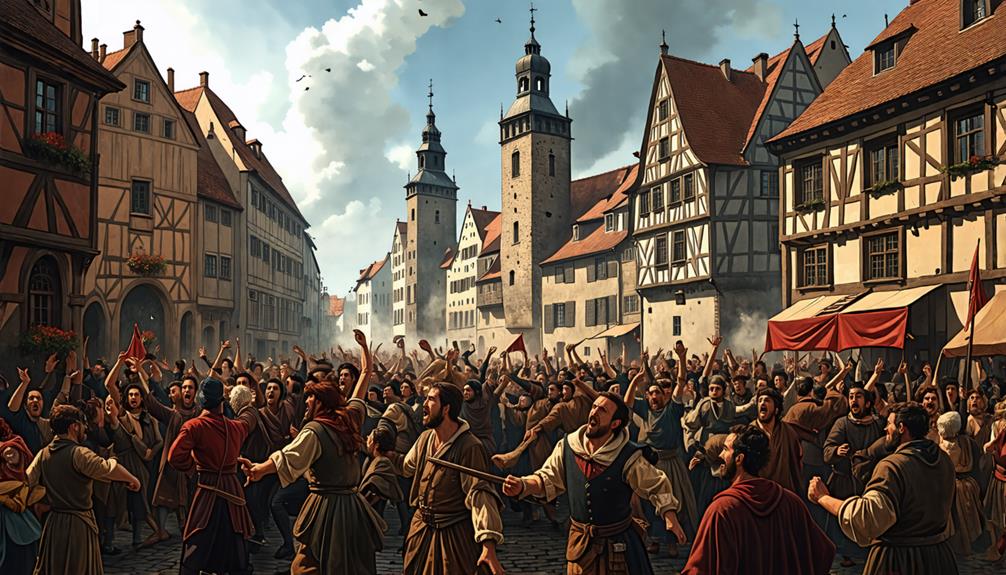
You're about to explore how the Strasbourg dancing plague has inspired various artistic expressions, from film to literature to music.
You'll see how creative works like Jonathan Glazer's short film and Kiran Millwood Hargrave's novel 'The Dance Tree' reflect themes of madness, liberation, and the complexities of human emotions.
As you consider these cultural representations, you'll discover how the phenomenon continues to resonate with modern audiences, sparking discussions about the power of collective experiences.
Artistic Expressions of Madness
Capturing the eerie and unbridled energy of the Strasbourg dancing plague, various artistic expressions have transformed this bizarre historical event into a symbol of the complex interplay between madness, movement, and societal constraints.
You'll find the dancing plague referenced in Florence and the Machine's song 'Choreomania,' which explores themes of madness and movement. Jonathan Glazer's short film 'Strasbourg 1518' also reflects on the societal implications of collective hysteria.
These artistic expressions highlight the tension between societal constraints and the liberating nature of dance, showcasing its role as a form of protest and self-expression. The dancing plague serves as a metaphor for societal anxieties, linking historical context to modern issues of mental health and collective behavior.
Historic Dance in Literature
Through the lens of literature, the Strasbourg Dancing Plague has been reimagined as a powerful symbol of resistance and self-expression, with authors like Kiran Millwood Hargrave weaving its dark history into narratives that explore the complex interplay between societal constraint and personal freedom.
You see how the dancers, including Frau Troffea, are portrayed as empowered figures, their dance a defiant assertion of autonomy within a restrictive society.
Works like Hargrave's 'The Dance Tree' investigate the emotional lives of the dancers, reflecting on the historical context that fueled their frenzied movements.
The phrase 'Dance Fever' becomes a metaphor for the infectious desire for freedom and self-expression, allowing you to connect the historical events with contemporary issues and the human emotions that drive us.
Music Inspired by Mania
As the Strasbourg Dancing Plague's dark history continues to inspire literary works, its influence also extends to the area of music, where artists like Florence and the Machine draw on the phenomenon to explore themes of collective behavior and mental health.
You'll find the dance epidemic's impact in Florence and the Machine's 2022 album 'Dance Fever', particularly in the song 'Choreomania'.
This track reflects the chaos and societal anxiety that Frau Troffea's dance mania embodied.
The song's themes of collective behavior and mental health serve as a demonstration of the dancing plague's lasting cultural significance.
Scholarly Works and Resources

Scholars have extensively studied the 1518 dancing plague, producing a range of works that offer insights into the phenomenon's historical context and underlying causes.
You can explore John Waller's book, 'A Time to Dance, A Time to Die,' which provides a thorough analysis of the event, exploring its connection to the Black Death and the societal repercussions that followed.
Researchers like Lynneth Miller examine the intersection of divine punishment and medical explanations, while Hecker's work links the dancing mania to mental health crises of the time.
You can also find studies on collective behavior in academic journals like Dance Research and American Imago, offering a detailed understanding of the dancing plague that consumed Strasbourg's citizens, baffling the city council and inspiring ongoing research.
Reactions to the Dance Mania
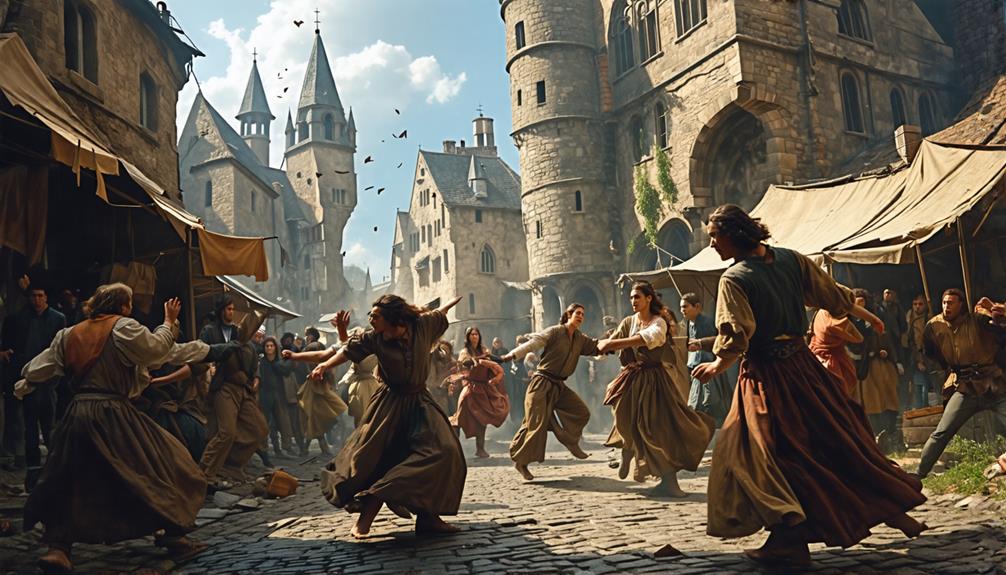
You'll notice that the reactions to the dance mania in Strasbourg varied as the situation unfolded.
At first, city authorities attempted to manage the phenomenon by encouraging more dancing, even hiring musicians to play along, but this only seemed to intensify the issue.
As you explore the civic response measures and musical intervention effects, you'll see how the authorities' tactics shifted from accommodating to prohibiting public dancing.
Civic Response Measures
Initially, the Strasbourg authorities responded to the dancing mania by actively supporting it, hiring musicians to accompany the dancers and setting up guildhalls to accommodate the growing number of participants.
You might think this was an odd decision, but civic leaders hoped that by facilitating the dancing, they could alleviate the compulsion that seemed to grip the dancers.
The city council even constructed a stage to manage the outbreak, bringing in professional dancers to assist the afflicted.
However, these measures only intensified the situation, leading to increased exhaustion and ultimately, fatalities.
As the crisis worsened, authorities were forced to ban public dancing and music in an attempt to quell the outbreak.
It was a desperate move, but the situation had become dire.
Musical Intervention Effects
The introduction of music, which city authorities hoped would calm the dancers, had the opposite effect, drawing in more participants and fueling the dance mania.
You can imagine the scene: a stage constructed, professional dancers performing, and the crowd swelling with an uncontrollable urge to join in.
But instead of relief, the music only intensified the outbreak. Physicians of the time thought they could calm the 'hot blood' of the dancers with rhythm and melody, but their musical intervention fell flat.
As you consider the Strasbourg dancing plague, it's clear that the city authorities' attempts to manage the situation through music only made things worse.
The phenomenon persisted until September, a demonstration of the inefficacy of their interventions.
Social and Psychological Factors
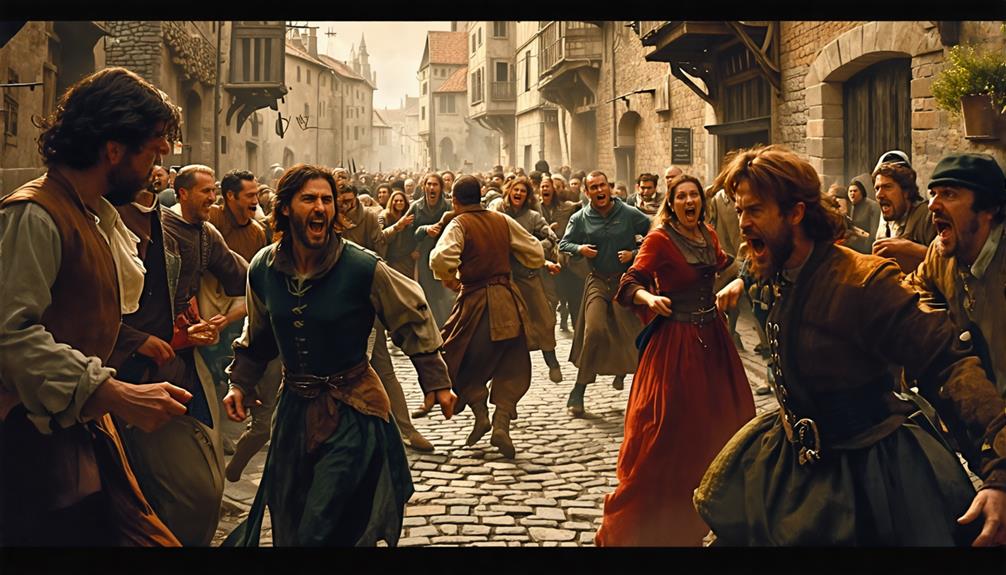
How did extreme psychological stressors, such as famine and disease, contribute to the outbreak of the 1518 dancing plague in Strasbourg, where hundreds of people began dancing uncontrollably in the streets?
You see, it's likely that the residents of Strasbourg experienced incredible psychological stress due to various factors, including food scarcity and the spread of illness.
This stress probably gave rise to a phenomenon similar to a mass psychogenic disorder, where people around you exhibited involuntary and contagious movements.
Societal pressures, such as expectations regarding behavior, likely triggered responses that escalated into widespread chaotic dancing.
This illustrates that the line between sanity, demonic possession, or so-called 'divine vengeance' was blurred at times, making it vital for you to reflect on context for understanding.
Theories of Mass Hysteria
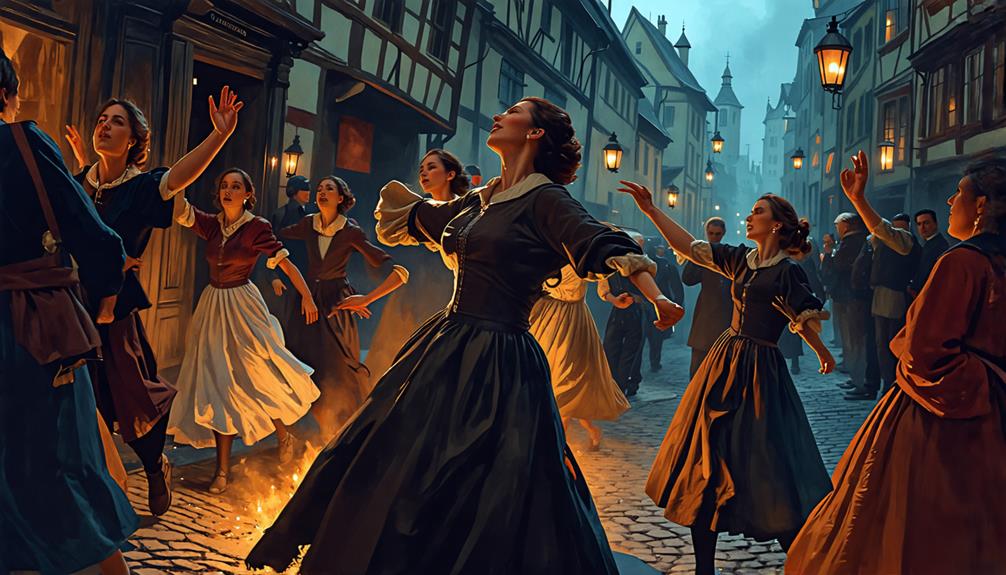
Mass hysteria theories provide a framework for understanding collective psychological responses to stressors, such as those witnessed during the 1518 Strasbourg Dancing Plague, where hundreds of individuals exhibited uncontrollable dancing behavior.
You can see how extreme societal stress, stemming from poor harvests and high grain prices, may have led to a mass psychogenic disorder among the dancers.
This phenomenon is often linked to the concept of 'choreomania,' where social and psychological pressures manifest as uncontrollable movements, reflecting the intersection of mental health and collective behavior.
Legacy of the Dancing Plague

From a historical standpoint, you can see the 1518 Strasbourg Dancing Plague as a lasting example of mass psychogenic illness, continuing to influence discussions about collective behavior and mental health crises today.
You notice its impact in various artistic representations, such as Florence + The Machine's album 'Dance Fever' and Jonathan Glazer's short film 'Strasbourg 1518', which highlight the ongoing cultural fascination with the event and its implications on societal dynamics.
The dancing plague is associated with themes of autonomy, particularly female expression, as seen in Kiran Millwood Hargrave's 'The Dance Tree'.
This phenomenon serves as a case study for understanding the impact of environmental stressors and psychological factors on community behavior during crises, making its legacy resonate in modern psychology and sociology.
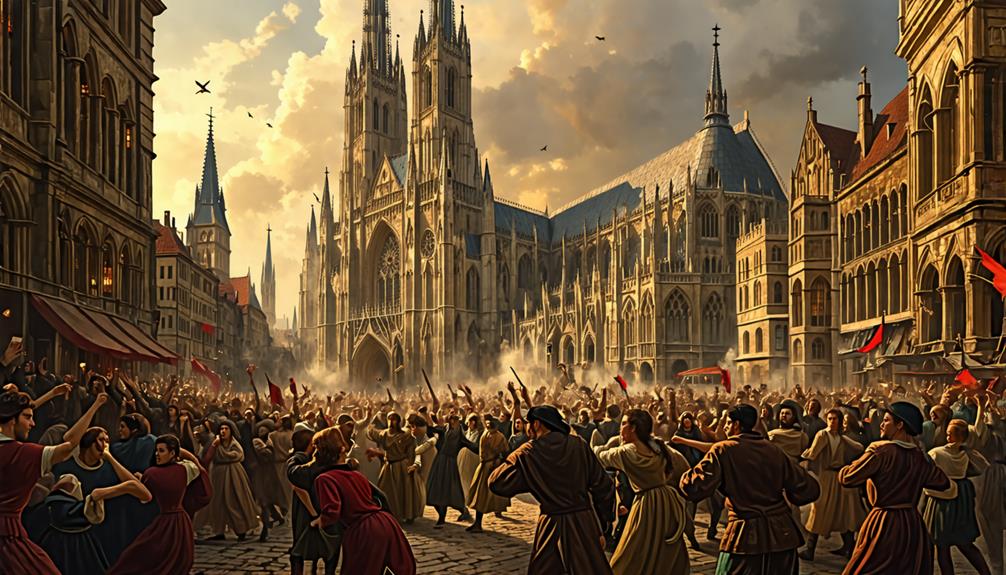
Leave a Reply